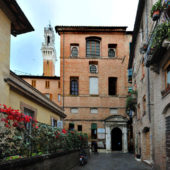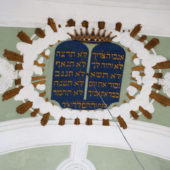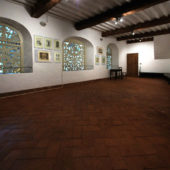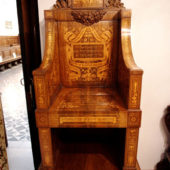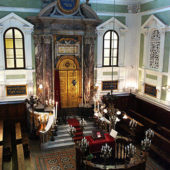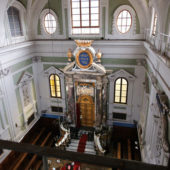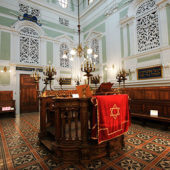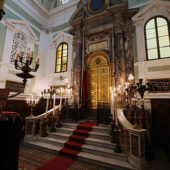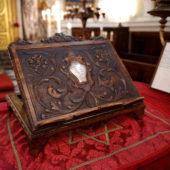This archetypal Tuscan hill city has been home to many famous Jewish scholars and rabbis.
By 1229 a Jewish community was established in Siena, with the breadwinners employed primarily in money lending, one of the few livelihoods open to them. In 1335 Vitale di Daniele received permission to open a bank in Siena; that Jewish banking business thrived in the city over the next 350 years. When the plague struck in 1348, the Jews were blamed and banished from living in the city center.
During the 15th century, the Jews of Siena lived in relative peace, despite the anti-Semitic barbs the Franciscan friars delivered during their sermons. In 1439, legislation was passed requiring all Jews, except bankers, to wear an “O” on their clothing. Two years later a judge was put in charge of dealing with all Jewish legal cases. This was viewed favorably and Jews were subsequently given permission to live and do business in the city center. In 1457 they were granted complete religious freedom. During the 16th century, the famous Jewish banker Ishmael de Rieti lived and worked in Siena. Many Jewish scholars and rabbis visited him. Jews were allowed to attend the University of Siena and between 1543 and 1600, at least eleven Jews graduated as physicians from the University.
A Yeshiva was founded in Siena, which made the city the center of Jewish religious studies for central Italy. In 1571, Duke Cosimo of the Medici family wanted to receive the title of Grand Duke; therefore, he obeyed the wishes of the church and established a Sienese ghetto, wherein all Jews in the city had to live, regardless of income or status. They also had to wear distinguishing clothing: a yellow cap for the men, and a scarf for the women, and they were forced to pay a special tax. Despite these hardships, the Jews of Siena prospered and many continued to study at the University. More anti-Jewish legislation was passed and eventually, Jews were forbidden to be involved in banking, to employ Christian workers and if merchants, were allowed to sell only second-hand merchandise.
By the 18th century, these restrictions had eased. In 1786 a new synagogue was built upon the same site in the ghetto where Jews had previously met to worship. The synagogue remains today, as the Siena Synagogue shown on this website. In March of 1799 the Jews were granted full emancipation, when Napoleon’s troops occupied the town. Their joy was short lived as in June of that year rioters from Arezzo ransacked and burned the ghetto, killing nineteen Jews. To this day the Jews of Siena commemorate this horrific event with an annual fast. Following the riot, many Jews left Siena; the Jewish community decreased from 500 in the 18th century to 300 in the 19th century. The community dwindled even further at the beginning of the 20th century to just 200 members, and by 1968, there were 100 Jews in the city. The ghetto existed until 1859 and in 1935 it was partially destroyed; some street signs are all that remain today.
Siena was home to many famous scholars in the 19th century: Meachem Azaria Castelnuovo (a Kabbalist), Samuele Nissim, Samuele Cabibbe, Angelo Paggi, and Dante Lattes (a scholar during WWI).
The Siena Synagogue was designed by Giuseppe del Rosso in 1786, in Rococo and Neo-classic styles. From the outside, the plain faced brick synagogue blends in with the other houses on the street. This is common of synagogues built prior to the emancipation. Nothing marks it as a synagogue except for the plaques on either side of the entranceway: the one on the left commemorates the deportees of WWII, and the one on the right remembers those died in WWI. Opposite the synagogue is the Via degli Archi, ghetto fountain, well-known to the Jews within the ghetto who probably depended upon it as their water supply.
Inside, the décor of the large, slightly rectangular prayer room is elegant and rich. The walls feature Neo-classical styling of white molding against green/blue walls, with arched windows downstairs, rectangular and circular windows upstairs, together with arched grill design and panels of scripture in Hebrew. The bimah was built in 1756, and is situated in the center of the room. The tivah (reader’s desk) is placed inside the balustrade with a red velvet throw draped over it, and an intricately hand-carved, antique book rest sitting on top. Nine candelabras with ten arms rise from its turned wood balustrade. The bimah sits on the elaborately patterned Tuscan tiled floor.
The Aron Kodesh sits at the far end of the prayer room, up several marble steps with a red runner lining the center of the steps. It is carved of marble in a Neo-classical design, with two columns on each side, supporting the crosshead and pediment, which encompasses twin tablets featuring the Ten Commandments. This surrounds the arched gilded doors, which house the Torah scrolls. The ceiling above the Aron Kodesh features white woodwork against the green/blue stock-work, surrounding royal blue twin tablets with the Ten Commandments, inscribed in Hebrew. The Aron Kodesh has minimal painting and gilding – it is a sumptuous feast for the eyes. Curved marble balustrades lead away from the Aron Kodesh outward, down the marble staircase, to the floor level of the prayer room. Standing menorahs flank either side of the Aron Kodesh. The women’s gallery is opposite. Simple wood benches fill the sanctuary. In the large entrance hall is the magnificent hand-carved Elijah’s chair, which was donated to the synagogue in 1860 by Rabbi Nissim. Carved into its back are verses referring to the circumcision ceremony, the rite for which it was built. The synagogue houses several rare fabrics called “Indians,” as well as many ritual silver items donated from the Guadagni family.
The synagogue is open for services on Friday nights, Shabbats, and High Holidays. It is also available for Bar and Bat Mitzvahs and other special events. It is also open for tourists Sunday 10-5, M-W 9-1.

